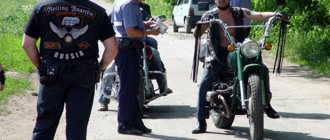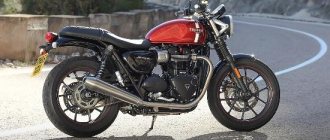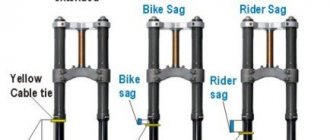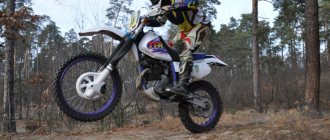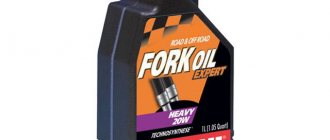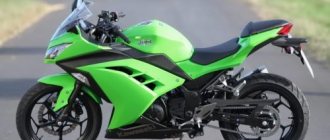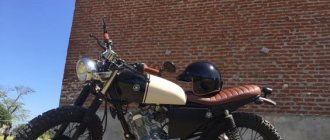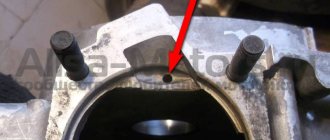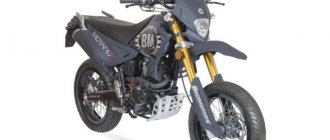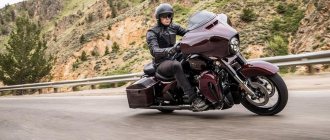Selecting an option. Preparation for inspection
We go to any private advertisement site, when you start looking at specific models, compare them even with each other, so you will learn to see common features and determine where it is painted, look at all the options for now without calling anyone. This will give you an idea of what these motorcycles might look like for different owners.
Be sure to learn how to identify stock (factory mirrors), steering wheel ends (weights), grips (handles), turn signals, footrests, clutch and brake levers. In a word, the parts that suffer the most when dropped, naturally, most used motorcycles are not the issue. If the parts are not stock, this is the first sign that it was not enough that it was dropped, and then they saved on restoration.
Then try to find a catch with options with too low a price because... Most likely it exists, either it has not been cleared through customs, or it is a scam where they scam people whose eyes have lit up at the price and are ready not to miss out on “an excellent option” as quickly as possible.
You don’t have to pay much attention to the stated mileage because... from the photo you are unlikely to determine its reality, so if the motorcycles are 10-20 years old, then the mileage and plus or minus 5 years do not matter much, and before drawing conclusions, you need to look at the condition, and not the mileage numbers or the date of manufacture.
The mileage and date of manufacture are important when you have two identical motorcycles at a similar price, and only if the mileage is real and appears at least on the auction list, if the owner has one. If we are talking about 600 cc motorcycles, then mileage of 50 thousand km is still a little, if the motorcycle has been looked after. But for example, for 250 cc this is already a bit much because... they do not work more often at maximum modes.
So, when you go for an inspection, you should already know about the development of the model in order to be sure which motorcycle is in front of you, if this was not clear from the photo in the ad. They must know by heart the standard coloring pages, where the stickers should be and what sizes.
Check List of Consumables
Make a Check List of Consumables that will be able to determine all additional expenses after purchase:
BRAKE SYSTEM:
- Front discs
- Front pads
- Brake hoses
- Rear disc
- Rear pads
- Rear brake hose
SUSPENSION:
- Oil seals/boots
- Fork feathers
- Wheel disks
- Wheel bearings
- Steering column bearings
- Pendulum bearings
TRANSMISSION:
- Chain
- Stars
- Clutch cable/hydraulic hoses
- Clutch discs
ELECTRICAL:
- Battery
- Lamps
- Candles Calling.
Next, go to the motorcycle spare parts website and write down the cost of consumables for your motorcycle in this list, print it out and take it with you.
Download the instruction manual for this motorcycle; it is not large and will give a lot of useful information if you read it.
Take a caliper with you to find out the remaining width of the brake discs, and be sure to study the permissible thickness of the brake discs for this model.
Don't make any decisions until you've looked at all the options. Therefore, go to the show with ease of mind, no one is forcing you to buy.
We have compiled a list of successful options and are starting to call. When calling the seller, there is no need to discuss anything yet, especially the price. If you do this, it will set you up for intransigence, as you can bargain without even seeing this motorcycle.
Another question is when you will arrive with real money and be able to show him that your condition is even worse than he himself thought before. All basic questions should be asked off guard and live, so no price discussions for now. You need to find out whether it is still for sale or not, ask whether it has been registered; this is a good indicator of legal frequency, but not a panacea.
Also ask how many owners there have been, the fewer the better. And if the information received suits you, especially regarding other options, then arrange an inspection and ask the seller not to start the engine before your arrival; a cold start will give more indicators than a warm one.
Key points during inspection
Well, we have arrived for an inspection and are starting with the key points in order to immediately understand whether it is worth talking further or not. The key points are: general appearance, engine, frame and chassis.
General form
Buying a used motorcycle is more like finishing the chances and probabilities because... We can only find out the real condition by disassembling the floor of the motorcycle. Therefore, we will have to rely on indirect indicators, often making only assumptions. And the general appearance is the most important thing, there seem to be contradictions in this because... nothing depends on the appearance and does not affect the characteristics, but the appearance tells us in what heavenly conditions or circles of hell the motorcycle has been.
Naturally, sometimes it happens that the owner does not care what his motorcycle looks like, but monitors its technical condition with great trepidation. But buying a used motorcycle is always a risk and there is a chance that a dead motorcycle has three ideal criteria at the same time: the engine, frame and chassis tend to infinity, but this chance still exists. How can you tell by its external features whether this motorcycle has been owned by a good owner or whether it has been abused for the last ten years?
It's time to remember what the stock mirrors, turn signal and everything on the steering wheel look like, because when you fall, these are the first things to break. if the grips are not original but Chinese, and the seller tells you that he installed tuned grips, do not believe that he installed them because they are better, most likely he broke the clip-ons or steering wheel, tore the original grips and supposedly the tuning one costs several times cheaper than the original one.
Of course, there are motorcycles on which everything is installed specifically for convenience or to improve results in races, but as a rule, these are all of a different quality and much more expensive than stock ones. On many motorcycles, if you look behind the fender, you can find traces of spider welding, which means that the motorcycle took a good beating at one time. Pay attention to aluminum parts, they oxidize over time, this is not a big deal, but compare whether they are equally oxidized.
Next, look at the bolts and nuts for fastening the plastic, where it is especially important to mount the engine to the frame; in some places they are missing and no one bothered to return the missing ones, and in some places the threads may have been torn off. Please make sure that there are original bolts everywhere, for example, on one side there is a hexagon bolt, on the other there is a regular one. When the general condition turns out to be acceptable for you, we begin to evaluate the engine.
Engine
As soon as you approach the motorcycle, check if there is antifreeze and oil, because some unfortunate owners drive and do not know that these fluids need to be checked and changed because... they tend to go towards the exhaust pipe. An overheated engine or one that has experienced oil starvation may work, but like a snowball there are irreversible processes in it that drag on one after another and can soon result in very expensive repairs.
Immediately ask the seller what kind of oil and antifreeze were filled in and when they were changed; if he tells you when they were changed and what color of antifreeze is already good. Many people change it without even knowing what is in there. Antifreeze must be clean, without cream or cloudy impurities, and there must be no traces of scale.
The oil should be either transparent yellowish if it has recently been changed, or brown, but it must be translucent. If the oil is black and does not shine through, it means that changing the oil on time is not the owner’s style. If the oil is too thick, they may be trying to hide signs of low oil pressure or wear.
Japanese motorcycles are indeed very reliable and this is not a myth, but even Japanese engineers are powerless against two things: time and unqualified service. In our conditions, we can only listen and watch, but there is a very objective way to find out the condition - a compression test. This method is not so simple and requires the presence of a compression meter and a person capable of using it correctly, but also the ability to persuade the owner to remove the tank and unscrew the spark plugs.
When the motorcycle is in its 2nd or 3rd decade, it is better to ponder this question: maybe the compression is normal, but what if it’s not. Compression can be low due to unadjusted valves, contaminated rings, or wear of the piston cylinder. The spread of compression values should be within about.5 atmospheres across all cylinders. It is necessary to check on a warm engine with the throttle fully open and a live battery.
When measuring compression, it is also a good idea to evaluate the condition of the spark plugs; the carbon deposits should be brick-colored. Without learning about the meaning of compression, you buy a motorcycle and it doesn’t work for you, and fixing this problem can cost a lot of money. If the motorcycle is relatively new, this procedure is less in demand.
External inspection of the engine
Whether you opened the engine or not, you can check if the sealant is squeezed out from under the valve cover or cylinder head because During factory assembly, the sealant will not come out anywhere, no matter what color it is. Pay attention to the originality and intactness of the fasteners of the clamps, to possible traces of tools in the connectors of the parts, traces of torn paint or jammed edges on them. If these signs are present, immediately ask why the engine was disassembled and where it was done.
If it was dismantled, then it’s better not to mess with everything because... there is a very low probability that it was assembled properly, especially since the person is selling it. Another thing that needs to be examined is whether there are any leaks, take a closer look at the engine being clean due to the fact that there is nothing leaking from it or it has just been recently wiped. Try to find traces of welding on the engine at the front, bottom and sides; if there are any, it’s better not to take risks when buying this motorcycle.
Check the clarity of the gear shift by clicking the lever and pushing the motorcycle a little here and there, you can check if the gears are flying out if you have the opportunity to ride the motorcycle; with good traction, the faulty gear will fly out.
Starting a cold engine. Get ready to watch how long it takes for the emergency oil pressure light to go out. it usually goes out within a second after starting, provided that the starter process has not been delayed, in which case it may go out before starting and this is a good sign.
If the engine is carburetor, it may not work stably for the first second and stalling is acceptable, but if it is an injection engine, this should not happen, provided that the start occurs at above-zero temperatures. Get ready to listen carefully to the sounds emanating from the engine; if, on a cold engine, you hear mid-tone knocks in the cylinder area that intensify when the gas is opened sharply, this indicates increased wear of the piston group cylinder, or excessively early ignition.
If after warming up the sounds disappear, then the motor will still live, but it’s no longer worth unscrewing. Let the engine run for 2-3 minutes, the engine should run smoothly without interruption.
If you hear small ringing high-pitched clacks, this is acceptable. It is necessary to distinguish the clattering of injectors from the clattering of valves. The injectors click quite audibly, but the nature of the operation is softer, there is less metal in the sound. If you hear a metallic clattering sound that stands out strongly in terms of sound level, this is worse, but can be resolved by adjusting the valves.
If you hear an increased metallic rolling noise, then it is a replacement of the timing chain and tensioner. If you hear ringing metallic sounds from the crankcase, that is, the lower part of the engine, which disappears when the clutch is pressed, it means the clutch discs or seats are worn out.
Evaluate the exhaust during the warming up process, white smoke is acceptable, and after warming up in a steady state, the gas jet of the exhaust should be invisible, if the smoke is black, the mixture is rich, if after warming up white smoke continues to flow, the mixture is poor, but this can be corrected by adjusting the carburetor, and if there is thick white smoke then antifreeze may get into the combustion chamber, and this is very bad; if the smoke is blue, it’s burning oil, which means the engine will need a major overhaul.
If everything is fine, raise the tachometer needle to medium speed and hold it for a while, pay attention, clouds of bluish smoke fly out, if this is the case, the oil of the removable valves will need to be replaced, the engine will require topping up the oil. There may also be misalignment of the piston rings, which can be indicated by reduced compression, in which case the motorcycle will ride worse than it could. But on two-stroke motorcycles, blue smoke is normal.
If there are no problems with the engine, we move on to the next equally important frame check.
Frame
The frame is no less important than the engine, if there is something wrong with it, then fixing it will cost you at least half a motorcycle. And most often, replacing the frame with subsequent re-registration of documents. The steering stops are very important; they can be found on the frame by turning the steering wheel as far as possible. If they are jammed or broken, this indicates that the motorcycle once fell significantly, and part of the impact fell on the fork. If these signs are present, check to see if everything is in order with the fork and frame in the traverse area. If only the paint on the limiters is worn off, this is normal. If dropped, the frame may bend or burst.
Ask a friend to stand the motorcycle upright, move 20 meters away and look at the front wheel; it should be perfectly level relative to the rear. Look at the frame close up if it is burst and it was welded, usually in the area of the traverse or fuel tank, in this case paint or uneven and bulky seams will be visible, or pay attention to their non-factory arrangement of shapes because The plant welds along smooth, clear joints of two parts; if the seam is not at the joint but on one of the parts or the geometry of the seam is arbitrary, then a crack has been welded. You can also find this place on the symmetrical side of the frame and evaluate the similarity.
For aluminum frames, as a rule, chaotic traces of cleaning and etching are visible before preparation before welding; at the factory, these traces are very small and uniform. If the frame is bent, you will see cracked paint or a characteristic accordion if it is a steel frame.
Chassis
It’s very good when there is a central stand; to check the bearings, just lift the front or rear of the motorcycle and move the wheel, fork, and pendulum. There should be no backlash anywhere. If there is no way to lift the motorcycle, you will have to push it and sharply press the front brake. If there is a knock, then these are two options; it’s time for some bearing to be replaced; it could be a wheel bearing, or one of the steering column bearings, enter all this in the Check List, and the second is play in the brake discs.
In the chassis, the wheels and fork are very expensive. Look around the entire circumference of the disc and there should be no signs of impact or editing. If the wheels are painted an unusual color and if they are not glossy from the factory, but what you see is glossy, then most likely they were corrected and then painted. After straightening, some ellipsoidality still remains, which will manifest itself at speed, plus the material loses its former strength. One wheel costs on average from five thousand rubles. If possible, hang the motorcycle wheels one at a time and rotate them by hand, assess by eye whether there is any runout of the rim or rubber, and at the same time you can evaluate the evenness of the brake discs.
The eye is a fairly accurate instrument, and if beats are noticeable, it means the wheel has been injured or has uneven rubber wear. such a wheel will hit at speed and in the same way with a fork, when the fork is adjusted, wave-like marks remain on it and, as a rule, are noticeable only to the touch. Usually the fork is bent directly under the traverse; look carefully at this place; one fork leg also costs from five thousand rubles. Check the pendulum for signs of non-factory welding and scratches.
Tires are always a good way to reduce the price if they are worn out. Wear will be shown by special indicators in the tread, and the date of manufacture will be shown by oval stamps - the date of manufacture, where the first numbers are which week of the year, and the second two are the year. If the tires are 3-4 years old, it is advisable to change them, even if the tread thickness is not bad. Its properties are significantly worse than those of a new one, especially if the motorcycle was stored in a cold garage.
Oil seals and forks require replacement when there is an oil film or even entire oil stains on the working surface of the pen. The seals need to be changed together with the anthers that we see from the outside, you need to make sure that the feathers do not have any play in the guides, to do this you need to lift the front again and move the wheel or pump the brakes. If there is play, as well as longitudinal cuts on the feathers, then replacing the oil seals will not help.
In this case, most likely you drove for a long time with leaky oil seals and anthers and the fork moved through the mud, as a result of which the entire fork may lose its image. Try to squeeze the fork as much as possible, there should be nothing gurgling or squelching in it, the motorcycle should calm down in one cycle of the suspension - compression, rebound, stopping - this is a very rough assessment, but this is an indicator that the suspension is at least not killed.
Registration of purchased vehicles with the traffic police
The new owner must register the vehicle in his name within 10 days. To do this, you must submit to the traffic police:
- personal documents;
- diagnostic inspection card;
- documents for the motorcycle (vehicle passport or customs documents, purchase and sale agreement);
- documents confirming payment of all necessary government fees;
- OSAGO insurance policy for a motorcycle.
In connection with the last point, the question often arises whether it is possible to buy a motorcycle without a category A license. Yes, you can buy a motorcycle without a driver’s license, but you will have to include in the compulsory motor insurance policy a person who has a license to drive a vehicle.
Condition of consumables
So, if there is nothing in these four main criteria that you would not like, the only thing left to decide is the price issue. If, after everything you have seen, you are satisfied with the motorcycle, it’s time to look at the condition of the consumables in order to have an idea of what expenses await you after the purchase. And at the very end you will need to make sure that everything is fine from a legal point of view. The main idea that should be remembered is that there will always be exactly the same motorcycle, for the same price, but without the jambs that you found only a matter of time. We take out the Check List with the prices you filled in and start counting.
Brake system
Press the front brake lever; it should not fall down or be pressed jerkily, if there is air in the system, if jerkily you will need to clean the brake master cylinder, but because... The brake fluid will have to be changed in any case, then this can all be fixed.
The most expensive thing in this system is the brake discs, try to move the discs, they should not be loose, if they are loose then 100% replacement, check the residual thickness of each disc, usually if the new disc is 4.5 mm then at least 3.5 mm thick is allowed, wear should be no more than 1 mm, if more, highlight in the Check List how much it will cost.
Brake pads usually have a special slot showing the remaining thickness; if there is less than 1 mm left of this slot, then add the cost of the pads. And the last thing you need to look at in the brake system is the hoses, if the hoses are not reinforced, look if there should be no cracks or cuts, and there shouldn’t be any leaks at the joints.
Clutch
Before checking, make sure that the clutch lever has free play, usually 5-10 mm. Next, start the engine, engage first gear and try to move off. if the motorcycle starts moving in the middle of the stroke, this is good, unless at the very end there is a replacement of the clutch discs ahead. Squeeze the clutch lever and look at the cable; it should be lubricated, and if instead of traces of lubricant there are traces of rust, then it will soon break.
If the clutch is hydraulic, there are no cracks or fluid leaks in the brake system. The chains have such a bad property of stretching, now you should understand how worn it is and how much it has worn off the sprockets. Criteria for replacing a chain: different tension when turning the wheel, loose rollers, rust on the rollers, tight rotation of the links relative to each other, change in color of the steel. The last three criteria are a consequence of insufficient lubrication and, as a result, overheating. Plus, try to pull the chain away from the rear sprocket; if at least half of the tooth becomes visible, then the chain is worn out and repeat the operation by rolling the motorcycle half a meter.
Electronics
It is difficult to check the condition of batteries without instruments, but for us the main indicator is whether the engine started or not. Before starting, turn on the ignition and check that all the lights on the dash come on. the main one is the emergency oil pressure indicator and the generator operation indicator; after starting they should go out. also check all the low and high beam lights, front and rear brake lights, front and rear turn signals, all motorcycles should have this and don’t forget about the sound signal. The speedometer can be either digital or analog.
Digital usually reads information from the gearbox, just ride the motorcycle in neutral and the speedometer will already show 1-2 km per hour. If it is analog, it usually reads from the front wheel, it needs to be hung out and turned. It wouldn’t be superfluous to remove the driver’s seat; as a rule, all the wiring and brains are hidden under it, look to see if there are extra wires according to the collective farm principle, if the standard wiring is oxidized, all this can be argued for reducing the price.
Appearance
In life, it’s always the case that problems with appearance can also help reduce the price. Torn seats 2-3 thousand, broken turn signal 500 rubles, dent on tank 5 thousand, worn or burst plastic 5 thousand rubles and crumpled exhaust pipe also 5 thousand rubles. Other elements that affect the price: if the radiator has dents, this means that stones flew into it or were not cleaned carefully, perhaps the motorcycle will heat up more than usual, also there should be no rust in the gas tank, otherwise sooner or later the entire fuel system will suffer, and removal rust from the inside of the tank is a troublesome matter.
Many advantages can persuade you to buy a specific option, for example: the necessary tuning, expensive forward flow, warming up the handles, saddlebags, high-quality sliders, alarm, a set of service keys, this set comes with most motorcycles from the factory, a set of ignition keys 2 pieces. Well, if you are completely satisfied with the motorcycle, all that remains is to check the documents.
Documentation
Take the title and check its number with the numbers on the frame to understand whether it is the right motorcycle, it is located on the right side of the steering column. If the PTS says that the number is missing, this means that the motorcycle was produced for the domestic Japanese market, they do not have a 17-digit number, they only have a short frame number, check that. Look carefully at the special notes column, all the information and nuances about a specific vehicle are written there, for example, if the motorcycle is under arrest or pledged to the bank.
Also pay attention to the column of the organization that issued the PTS, any customs office must be indicated, if one hundred is indicated, this is the traffic police, then there are three options: there were so many owners that the place in the PTS ran out, the original PTS was lost, or a stolen motorcycle with broken numbers was registered through a familiar traffic cop .
Be sure to look at the seller’s passport to make sure that this is the owner of the motorcycle and check the data with the current owner of the title. And if you are buying from a legal entity, ask for a power of attorney from the person who will issue it for you, it must have the original seal and signature of the director of this organization, exactly the same seal as on the PTS, in the column of the current owner. The purchase and sale agreement is always standard; download the forms on the Internet. The new owner enters the PTS independently, putting two signatures on the PTS and the contract. Well, that's it, you are the owner.
Previous posts: «MINI Cooper SD (Mini Cooper SD) diesel |
Breakthrough of the Belarusian automobile industry » Tags: Used motorcycle
How to register the purchase and sale of a motorcycle
Currently, when selling vehicles, including motorcycles, the concluded sales contract does not require notarization. It can be handwritten or on a form printed from the Internet. The agreement includes:
- information about the parties to the transaction;
- information about the motorcycle;
- contract value;
- payment procedure;
- transport transfer procedure.
The contract must bear the date of its execution and signatures of the parties.
An annex to the contract is the transport acceptance certificate. In principle, the agreement can be concluded orally, but then the seller, together with the new owner, will have to come to the traffic police for re-registration.
